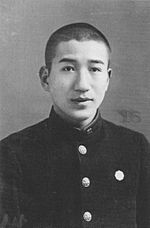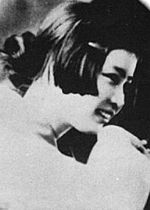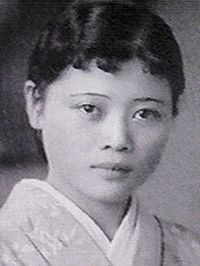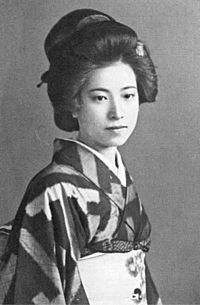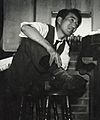Osamu Dazai facts for kids
Quick facts for kids
Osamu Dazai
|
|||||
|---|---|---|---|---|---|
| 太宰 治 | |||||
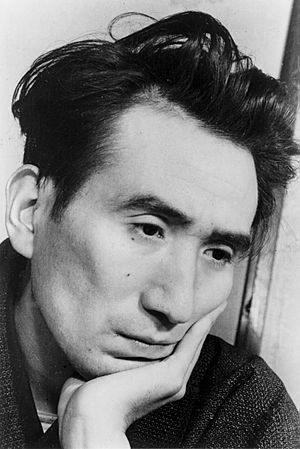
Dazai in 1948
|
|||||
| Born |
Shūji Tsushima
June 19, 1909 Kanagi, Aomori, Empire of Japan
|
||||
| Died | June 13, 1948 (aged 38) Tokyo, Allied-occupied Japan
|
||||
| Occupation | Novelist, Short story writer | ||||
|
Notable work
|
|
||||
| Movement | I-Novel, Buraiha | ||||
| Japanese name | |||||
| Kanji | 太宰 治 | ||||
| Hiragana | だざい おさむ | ||||
|
|||||
Osamu Dazai (太宰 治, Dazai Osamu, born Tsushima Shūji (津島修治) in 1909; died 1948) was a Japanese author. A number of his most popular works, such as The Setting Sun (Shayō) and No Longer Human (Ningen Shikkaku), are considered modern-day classics.
His influences include Ryūnosuke Akutagawa, Murasaki Shikibu and Fyodor Dostoyevsky. While Dazai continues to be widely celebrated in Japan, he remains relatively unknown elsewhere, with only a handful of his works available in English. His last book, No Longer Human, is his most popular work outside of Japan.
Early life
Shūji Tsushima (津島修治, Tsushima Shūji), who was later known as Osamu Dazai, was born on June 19, 1909, the eighth surviving child of a wealthy landowner in Kanagi, a remote corner of Japan at the northern tip of Tōhoku in Aomori Prefecture. At the time of his birth, the huge, newly-completed Tsushima mansion where he would spend his early years was home to some thirty family members. The Tsushima family was of obscure peasant origins, with Dazai's great-grandfather building up the family's wealth as a moneylender, and his son increasing it further. They quickly rose in power and, after some time, became highly respected across the region.
Dazai's father, Gen'emon (a younger son of the Matsuki family, which due to "its exceedingly 'feudal' tradition" had no use for sons other than the eldest son and heir) was adopted into the Tsushima family to marry the eldest daughter, Tane; he became involved in politics due to his position as one of the four wealthiest landowners in the prefecture, and was offered membership into the House of Peers. This made Dazai's father absent during much of his early childhood, and with his mother, Tane, being ill, Tsushima was brought up mostly by the family's servants and his aunt Kiye.
Education and literary career
In 1916, Tsushima began his education at Kanagi Elementary. On March 4, 1923, Tsushima's father Gen'emon died from lung cancer, and then a month later in April Tsushima attended Aomori High School, followed by entering Hirosaki University's literature department in 1927. He developed an interest in Edo culture and began studying gidayū, a form of chanted narration used in the puppet theaters. Around 1928, Tsushima edited a series of student publications and contributed some of his own works. He also published a magazine called Saibō bungei (Cell Literature) with his friends, and subsequently became a staff member of the college's newspaper.
In the 1930s and 1940s, Dazai wrote a number of subtle novels and short stories that are autobiographical in nature.
Japan entered the Pacific War in December, but Tsushima was excused from the draft because of his chronic chest problems, as he was diagnosed with tuberculosis.
A number of the stories which Dazai published during World War II were retellings of stories by Ihara Saikaku (1642–1693). His wartime works included Udaijin Sanetomo (Minister of the Right Sanetomo, 1943), Tsugaru (1944), Pandora no hako (Pandora's Box, 1945–46), and Otogizōshi (Fairy Tales, 1945) in which he retold a number of old Japanese fairy tales with "vividness and wit."
Dazai's house was burned down twice in the American bombing of Tokyo, but his family escaped unscathed, with a son, Masaki (正樹), born in 1944. His third child, daughter Satoko (里子), who later became a famous writer under the pseudonym Yūko Tsushima (津島佑子), was born in May 1947.
In the immediate postwar period, Dazai reached the height of his popularity. He depicted a dissolute life in postwar Tokyo in Viyon no Tsuma (Villon's Wife, 1947), depicting the wife of a poet who had abandoned her and her continuing will to live through hardships.
In 1946, Osamu Dazai released a controversial literary piece titled Kuno no Nenkan (Almanac of Pain), a political memoir of Dazai himself. It describes the immediate aftermath of losing the second World War, and encapsulates how Japanese people felt following the country's defeat.
Alongside this Dazai also wrote Jugonenkan (For Fifteen Years), another autobiographical piece.
In July 1947, Dazai's best-known work, Shayo (The Setting Sun, translated 1956) depicting the decline of the Japanese nobility after the war, was published, propelling the already popular writer into celebrityhood.
Dazai's health deteriorated rapidly. At this time he met Tomie Yamazaki (山崎富栄), a beautician and war widow who had lost her husband after just ten days of marriage. Dazai effectively abandoned his wife and children and moved in with Tomie.
Dazai began writing his novel No Longer Human (人間失格 Ningen Shikkaku, 1948) at the hot-spring resort Atami. He moved to Ōmiya with Tomie and stayed there until mid-May, finishing his novel. The book is considered one of the classics of Japanese literature and has been translated into several foreign languages.
In the spring of 1948, Dazai worked on a novelette scheduled to be serialized in the Asahi Shimbun newspaper, titled Guddo bai (the Japanese pronunciation of the English word "Goodbye") but it was never finished.
Death
On June 19, 1948, Dazai and Tomie were found drowned in the rain-swollen Tamagawa Canal, near his house. Danzai was 38 at the time of his death. His grave is at the temple of Zenrin-ji, in Mitaka, Tokyo.
Major works
| Year | Japanese Title | English Title | Comments |
|---|---|---|---|
| 1933 | 思い出 Omoide | Memories | in Bannen |
| 1935 | 道化の華 Dōke no Hana | The Flowers of Buffoonery | in Bannen |
| 1936 | 虚構の春 Kyokō no Haru | False Spring | in Bannen |
| 1936 | 晩年 Bannen | The Late Years | Collected short stories |
| 1937 | 二十世紀旗手 Nijusseiki Kishu | A standard-bearer of the twentieth century | |
| 1939 | 富嶽百景 Fugaku Hyakkei | One hundred views of Mount Fuji | |
| 女生徒 Joseito | Schoolgirl | ||
| 1940 | 女の決闘 Onna no Kettō | Women's Duel | |
| 駈込み訴へ Kakekomi Uttae | Heed My Plea | ||
| 走れメロス Hashire Merosu | Run, Melos! | ||
| 1941 | 新ハムレット Shin-Hamuretto | New Hamlet | |
| 1942 | 正義と微笑 Seigi to Bisho | Right and Smile | |
| 1943 | 右大臣実朝 Udaijin Sanetomo | Minister of the Right Sanetomo | |
| 1944 | 津軽 Tsugaru | Tsugaru | |
| 1945 | パンドラの匣 Pandora no Hako | Pandora's Box | |
| 新釈諸国噺 Shinshaku Shokoku Banashi | A new version of countries' tales | ||
| 惜別 Sekibetsu | A farewell with regret | ||
| お伽草紙 Otogizōshi | Fairy Tales | Collection of short stories | |
| 1946 | 冬の花火 Fuyu no Hanabi | Winter's firework | Play |
| 苦悩の年鑑 Kuno no Nenkan | Almanac of Pain | Autobiography | |
| 十五年間 Jugonenkan | For Fifteen Years | Autobiography | |
| 1947 | ヴィヨンの妻 Viyon No Tsuma | Villon's Wife | |
| 斜陽 Shayō | The Setting Sun | ||
| 1948 | 如是我聞 Nyozegamon | I heard it in this way | Essay |
| 桜桃 Ōtō | A Cherry | ||
| 人間失格 Ningen Shikkaku | No Longer Human | (2018 English Translation/Variation: A Shameful Life) | |
| グッド・バイ Guddo-bai | Good-Bye | Unfinished |
See also
 In Spanish: Osamu Dazai para niños
In Spanish: Osamu Dazai para niños
- Dazai Osamu Prize
- List of Japanese writers
- Osamu Dazai Memorial Museum
Images for kids


